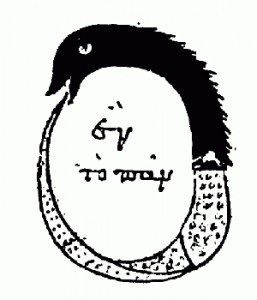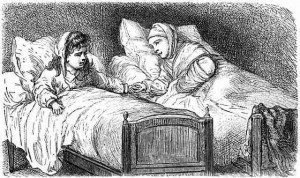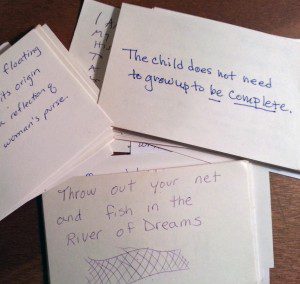 As I lay in bed early on a rainy Saturday morning, it occurred to me that the drifty state after waking can sometimes be – quite literally – the Solution State.
As I lay in bed early on a rainy Saturday morning, it occurred to me that the drifty state after waking can sometimes be – quite literally – the Solution State.
I did not initially have narrative dream recall. Instead, I found that my mental field was like an ocean of clean, translucent oil, in which many images and ideas were floating and bobbing. I could reach around and choose some of them to mix and match, and to bring into clear resolution. As I did this, I was given very clear solutions to a number of specific problems and imagery sequences I could now develop – or allow to develop – into dream movies with plotlines.
It struck me that this kind of experience takes place in a kind of dream matrix that could be called a Solution in the sense that many elements and possibilities are suspended in it – and that creative people have the ability, in that state of relaxed attention (or attentive relaxation) of entering the Solution State to bring through solutions.
In The Secret History of Dreaming,, I describe how in many fields – most notably in the history of scientific breakthroughs – the Solution State has been the vital place of creation. Many of our greatest scientists have been dreamers in a more expansive sense. Above all, they have known how to enter into a fluid state of consciousness where unlikely connections can be made that escape the workaday mind, and where the shapes of what was formerly inexpressible rise from the depth like creatures from the ocean bed.
One of the most famous – and problematic – “dreams” in the history of science. This is the dream of a snake biting its tail that revealed the shape of the benzene ring to German chemist August Kekulé (1829-1896). You’ll find it mentioned in almost any book that contains stories about dreams and creativity. But was it a sleep dream, or an image that came in a lightly altered state of consciousness?
Kekulé wrote a personal account, reconstructing an extempore speech he gave at the 1890 Benzolfest many years after his visions. Study this closely, and check the meaning of the German words, and you’ll find that his dreamy perception of the “dance” of chemical elements was not a one-off affair. He described a similar experience seven years before the snake dream that gave rise to his theory of chemical structures. He made it clear that in years between the two visions he had developed a practice of seeing or thinking in visual imagery.
In his mid-20s, when he was living near Clapham Common in London, Kekulé spent a long summer evening sharing his ideas with a friend and fellow chemist who lived in Islington, on the other side of the city. Riding home on the last bus, Kekulé drifted into a reverie (Traumerei) in which he saw atoms “gamboling” and dancing and forming combinations. He understood, when he analyzed their motions, that he had been given clear insights into chemical structures. Up to this time, he had been unable to grasp the nature of their motion. “Now, however, I saw how, frequently, two smaller atoms united to form a pair; how a larger one embraced the two smaller ones…while the whole kept whirling in a giddy dance. I saw how the larger ones formed a chain, dragging the smaller ones after them but only at the end of the chain.” He stayed up late that night sketching these “dream forms”. This was the origin of his theory of carbon bonding in chemical structures.
We see three conditions for creativity at work in this incident: (a) immersion in a subject, (b) sharing a developing idea with the right friend, and (c) drifting or relaxing into a flow state, from which the “Eureka” moment arises spontaneously..
Seven years later, a dream or reverie during an evening nap showed Kekulé the chemical structure of the benzene ring. He was now a professor in Ghent in Belgium. Dozing by the fire in his darkened study, he again saw atoms “gamboling before my eyes.” Now his inner sight “rendered more acute by repeated visions of the kind, could distinguish larger structures of manifold conformation: long rows, sometimes more closely fitted together all twining and twisting in snake-like motion.” Then he was startled to see one of the “snakes” seize hold of its own tail, and whirl “mockingly” before him. He was jolted out of his languorous state, “as if by a lightning bolt.” The image of the whirling snake gave the chemist the clue to the structure of the benzene ring. He spent most of the night that followed working this up until he had shaped his theory.
Kekulé had become practiced in receiving and developing helpful images in this way. When he described the roots of his scientific creativity in the Benzolfest in his honor in 1890, Kekulé told his audience, “Let us learn to dream, gentlemen, then perhaps we shall find the truth.” He added the salutary caution, “But let us beware of publishing our dreams till they have been tested by the waking understanding.”
The images that came to Kekulé would have been meaningless, in terms of chemistry, to someone who did not have a scientific mind that had long been working on the problems whose solutions they revealed. The imagery might have sent an artist off to paint, or sent someone with an interest in myth off to study the symbol of the Ouroboros in the ancient world and in alchemy.
When Kekulé urged his audience to “dream”, he was surely not talking exclusively, or primarily, about what happens in sleep. He was talking about developing the ability to enter a state of relaxed attention in which ideas take form and interact as images.

